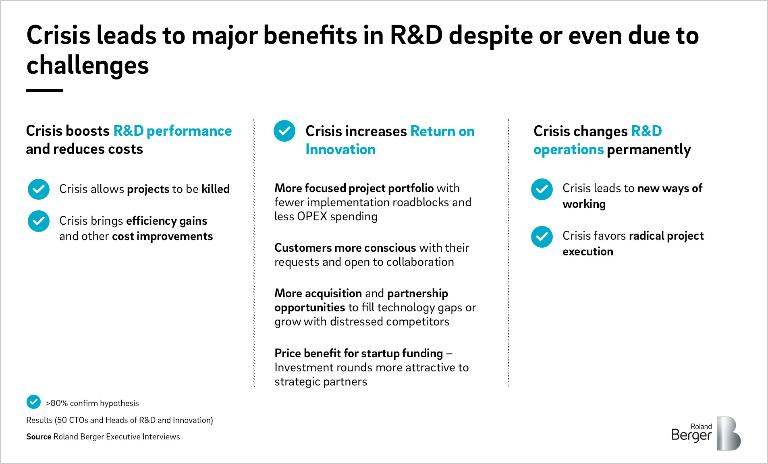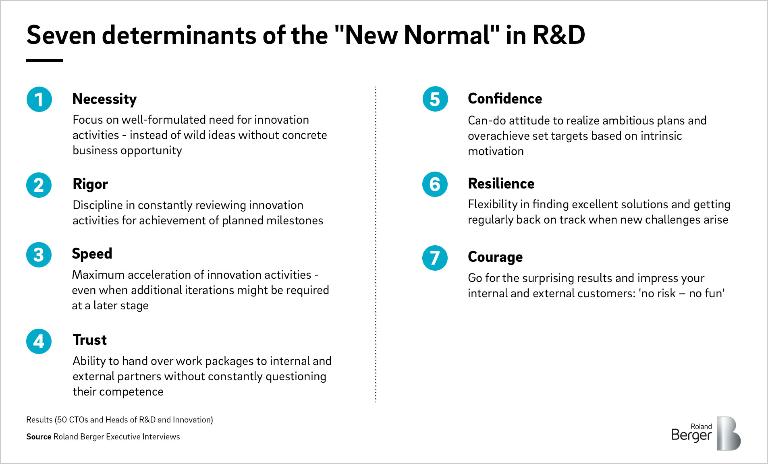Steffen Gackstatter discuss the latest trends in R&D transformation - including guerrilla tactics. The R&D Lab is explaining our #OPERA 2030 framework, its guiding principles and impact on research and development.


R&D: More successful in a crisis? Investments in innovation pay off
How to learn from crisis to increase Return on Innovation
Current projects may be put on hold or killed completely, while new ones do not get off the ground because money is scarce or the required materials are missing: There are many good reasons why innovations are not exactly booming during a crisis.

"Crises can have a positive influence on a company's innovativeness, because once the level of distress is great enough, sometimes an immovable tanker can transform into an agile speedboat in the blink of an eye. It is important to take action now to benefit from these learnings while they are still in people's mind."
It is therefore not surprising that various studies suggest this was (or still is) the case in the Covid-19 pandemic. In a survey by the "Expertenkommission Forschung und Entwicklung", for example, only a minority of respondents with R&D responsibility reported newly initiated projects. Staff shortages and a lack of digital maturity contribute to the overall rather negative innovation balance.
The picture reflects a tale of two halves: While many traditional players dialed down their research & development activities right at the start of the pandemic, another group was able to absolutely use the new situation to their advantage by actively investing in new products and solutions. This more successful group not only included medical technology manufacturers and pharmaceuticals companies , who brought disinfectants, respirators, masks, and vaccines to the market in record time, but also some forward-looking players that focused and reoriented their business during the crisis.
Investing during a crisis will put you in a better position later
From a historical viewpoint, groundbreaking innovations that emerge in the aftermath of particularly hard times are not a new phenomenon. Quite the opposite: Both after the Great Depression in the 1930s and after the oil price shock, the bursting of the dot-com bubble, and the financial crisis, companies willing to invest in research made successful coups with their innovations.
In fact, the way R&D is handled during crises and recessions seems to be a success factor for overcoming them. How it works can be summarized in the following formula: The more anti-cyclic investments a company makes, the fewer staff they have to lay off during and after the crisis. And the smarter the spending on research & development , the greater the subsequent increase in revenue.
Crises have a "cleansing" effect
So far, so good. But how do you successfully make use of difficult times to create a better future? How does the higher return on innovation occur and what can companies learn from those who have come through recession in good condition?
We tested five hypotheses to find this out, discussing and confirming them in interviews with the CTOs and heads of R&D of 50 companies from various industries:
- Hypothesis 1: The willingness to kill projects increases during a crisis. Plans with low prospects, nice-to-have projects, and "playgrounds" of individual departments will generally be eliminated more consistently and more quickly in phases of intense financial pressure.
- Hypothesis 2: Crises allow for efficiency gains and cost reductions. By reducing administrative tasks and letting less-qualified employees go, efficiency can be increased by 10 to 15 percent, freeing up resources to deliver strategically relevant projects.
- Hypothesis 3: Crises improve the return on innovation because more questions are asked about where the added value of projects lies. At the same time, many companies use the often favorable opportunity to make acquisitions or enter new partnerships at lower cost than before.
- Hypothesis 4: Crises promote new ways of thinking and working. Long-planned innovations such as agile and remote working, autonomous teams, and investing more trust in employees and suppliers are often easier to implement in exceptional situations – out of sheer necessity – than in regular operations.
- Hypothesis 5: Crises enable more radical implementation. Faster decision-making, greater willingness to take risks, openness to temporary solutions, all of which leads to a significantly more motivated workforce: In times of necessity, new ideas can suddenly be implemented at record speed.
In our experience, the key to successfully overcoming a crisis lies principally in these four areas:
- Resilient portfolios: Product diversification and new products that directly address the crisis (e.g. spray disinfectants in the Covid-19 pandemic) are now as important as a strict focus on value owing to the prioritization of R&D and innovation projects with high business impact. Anti-cyclic investments have proven to be successful. For this reason, companies should establish budgets for startups and innovations particularly in times when others are hesitating or pulling back from spending.
- Fast decision-making: Accelerate development by enabling your teams to tackle challenges for overcoming a crisis in a much shorter time than usual. Promote co-development by involving customers and other partners from day one.
- Results-oriented thinking: Encourage project sponsors and owners to scrutinize their projects through self-reflection. Failing is a part of the process and will lead to steep learning curves. A new culture of trust is also very important: Give partners inside and outside your department more freedom and be confident that they will value it.
- Optimized workforce: True cost reduction requires a fundamental restart rather than a step-by-step reduction. Zero-based approaches are therefore the right choice at this time. Crises are also the best time to implement upskilling projects and to make use of the productivity of high performers in targeted ways.
The new normal for R&D: What will change and what will stay the same?
Every crisis comes to an end at some point. But which of the developments of the past months will shape R&D long term?
We and our interviewees are convinced that clarity, consistency, speed, and trust will continue to be the core values of an efficient R&D organization. But there will also be a reorientation in how innovation projects are delivered. We have adapted our own approach to innovation and transformation projects in line with the study results.
Factors such as resilience and flexibility now play a significantly greater role in the analysis phase, for example. More radical scenarios are modeled, and extreme ambitions considered in the concept phase. Thinking and planning in broader contexts and ecosystems also strengthens a company's resilience during a crisis. And if, previously, implementation phases were often characterized by detailed specifications that the employees had to more or less rigidly follow, in the future processes for delivering innovation will be significantly more interactive, agile, and modifiable. Ultimately, circumstances are simply changing too fast right now for a solution selected back at the start to truly be the optimal one at the end.
If you are interested in participating in further R&D events or would like to receive further material on this topic, please contact Steffen Gackstatter.
Register now to receive regular insights into our Operations topics.







